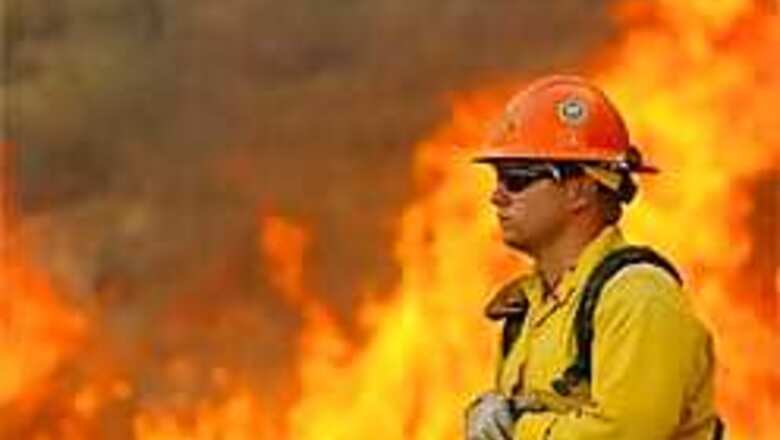
views
Yucca Valley (California): Thousands of firefighters aided by aircraft worked Friday in fierce heat to keep two big wildfires from gaining a foothold in the heavily populated San Bernardino Mountains, where millions of trees killed by drought and bark beetles could provide explosive fuel.
The lightning-caused fires, covering more than 95 square miles combined, merged Friday afternoon. Wildfires can grow more unpredictable after merging, but the two blazes were moving slowly Friday and US Forest Service officials said it appeared that their combination was unlikely to seriously increase fire activity.
The larger of the two fires has destroyed 45 homes and 118 outbuildings and remained a potential threat to 1,500 homes, said Kristel Johnson of the US Forest Service. The 53,000-acre blaze started a week ago on the Mojave Desert floor below the eastern flank of the San Bernardinos, and was 20 per cent contained.
The smaller fire had burned 8,300 acres, mostly at higher elevations. Though heavy smoke continued to fill the sky Friday, wind was pushing that fire away from the mountaintop Big Bear resort region and onto areas already burned by the larger fire.
Several thousand people live in and around Big Bear Lake, which went through its last big scare in Southern California's onslaught of devastating wildfires in 2003.
"There's no danger to Big Bear residents, there's no imminent threat at this time," said Tracey Martinez, a San Bernardino County Fire Department spokeswoman. However, about 75 scattered homes and a fish hatchery remained in the fire's path.
Some 2,700 firefighters labored in triple-digit heat. Fire officials said it was still important to establish a line to keep flames from moving into the wilderness of dead trees on the slopes leading up to resort communities.
PAGE_BREAK
"It's a real critical piece of line, if we can construct it and hold it," California Department of Forestry Capt. James Yazloff said. "It's very critical we don't allow it to go up to Big Bear."
Concerns about what would happen when the fires merged focused on the possibility of an ultra-hot fire front that could create its own unpredictable winds, but a merger also can create firebreaks by quickly burning up brush in each fire's path.
"They're going to burn each other out in that area," predicted Tracey Martinez, a San Bernardino County Fire Department spokeswoman.
Firefighters in southern Montana, mostly east of Billings, were battling three major fires totaling close to 150,000 acres, or more than 230 square miles.
The estimate on the largest fire nearly tripled overnight, fire information officer Paula Rosenthal said.
More than 200 structures, more than 80 of them homes, were threatened by the fires, and another blaze near Ashland destroyed at least one house.
Firefighters were close Friday to containing a wildfire that destroyed five buildings earlier this week.
Meteorologists had bad news for firefighters in southern Montana and California's Mojave Desert and foothills: Both parched areas were expected to see weekend thunderstorms that could trigger more lightning-caused wildfires.
Other wildfires around the West included an 850-acre blaze that forced the closure of southern Nevada's Beaver Dam State Park since lightning started it late Tuesday.
The park reopened Friday, and authorities said the blaze was 50 percent contained.



















Comments
0 comment